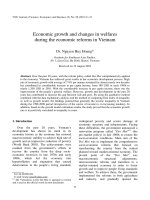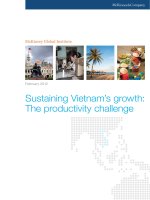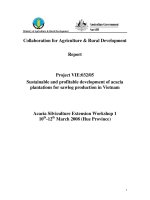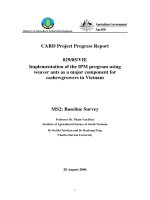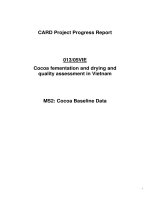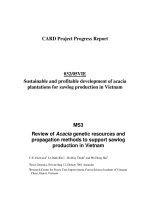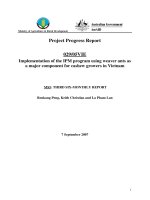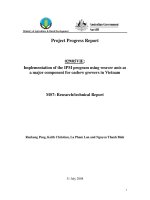mgi sustaining growth in vietnam full report
Bạn đang xem bản rút gọn của tài liệu. Xem và tải ngay bản đầy đủ của tài liệu tại đây (1.44 MB, 60 trang )
McKinsey Global Institute
Sustaining Vietnam’s growth: The productivity challenge
McKinsey Global Institute
Sustaining Vietnam’s growth:
The productivity challenge
February 2012
Copyright © McKinsey & Company 2012
The McKinsey Global Institute
The McKinsey Global Institute (MGI), the business and economics research
arm of McKinsey & Company, was established in 1990 to develop a deeper
understanding of the evolving global economy. Our goal is to provide leaders
in the commercial, public, and social sectors with facts and insights on which
to base management and policy decisions.
MGI research combines the disciplines of economics and management,
employing the analytical tools of economics with the insights of business
leaders. Our “micro-to-macro” methodology examines microeconomic
industry trends to better understand the broad macroeconomic forces
affecting business strategy and public policy. MGI’s in-depth reports have
covered more than 20 countries and 30 industries. Current research focuses
on six themes: productivity and growth; global nancial markets; technology
and innovation; urbanization; the future of work; and natural resources.
Recent reports have assessed job creation, resource productivity, cities of the
future, and the impact of the Internet.
MGI is led by three McKinsey & Company directors: Richard Dobbs, James
Manyika, and Charles Roxburgh. Susan Lund serves as director of research.
Project teams are led by a group of senior fellows and include consultants
from McKinsey’s ofces around the world. These teams draw on McKinsey’s
global network of partners and industry and management experts. In addition,
leading economists, including Nobel laureates, act as research advisers.
The partners of McKinsey & Company fund MGI’s research; it is not
commissioned by any business, government, or other institution. For further
information about MGI and to download reports, please visit www.mckinsey.
com/mgi.
McKinsey & Company in Vietnam
McKinsey & Company is a global management consulting rm that helps
many of the world’s leading organisations address their strategic challenges,
from reorganising for long-term growth to improving business performance
and maximising revenue. With consultants deployed in more than 50
countries across the globe, McKinsey advises on strategic, operational,
organisational and technological issues. For more than eight decades, the
rm’s primary objective has been to serve as an organisation’s most trusted
external adviser on critical issues facing senior management.
McKinsey established an ofce in Hanoi in 2008 with a team of global and
local professionals. Today, the ofce employs more than 50 Vietnamese staff
and serves private local companies, state-owned enterprises, and the public
sector in Vietnam, as well as multinational corporations and international
nancial institutions interested in building their presence in the country.
McKinsey Global Institute
Sustaining Vietnam’s growth:
The productivity challenge
Marco Breu
Richard Dobbs
Jaana Remes
David Skilling
Jinwook Kim
February 2012
Vietnam’s economy has grown rapidly since the country opened its economy
in the 1980s, and today foreign investors consistently rank it as one of the most
attractive investment destinations in Asia. The McKinsey Global Institute therefore
decided to provide a perspective on the challenges and opportunities facing the
Vietnamese economy over the next decade. In Sustaining Vietnam’s growth: The
productivity challenge, we find that although Vietnam has posted a very strong
performance over the last 25 years, today the economy faces complex challenges
that require a transition to a productivity-driven growth trajectory.
Marco Breu, a McKinsey director based in Hanoi; Richard Dobbs, McKinsey
and MGI director based in Seoul; Jaana Remes, MGI senior fellow based in
San Francisco; and David Skilling, former MGI senior fellow in Singapore, led
this project. Jinwook Kim managed the project team, which comprised Pham
Quang Anh, Hyungpyo Choi, Sanjeev Kapur, Nguyen Mai Phuong, Sunali Rohra,
Vishal Sarin, Ha Thanh Tu, and Le Thi Thanh Van. The team also benefited
from the guidance of Jonathan Auerbach, Heang Chhor, Andrew Grant, Tomas
Koch, Diaan-Yi Lin, Jens Lottner, Barnik Maitra, Jean-Marc Poullet, Badrinath
Ramanathan, Alfonso Villanueva-Rodriguez, Brian Salsberg, Joydeep Sengupta,
Seelan Singham, Shatetha Terdprisant, and Oliver Tonby. The team appreciates
the contribution of Janet Bush, MGI senior editor, who provided editorial support;
Rebeca Robboy, MGI external communications manager; Julie Philpot, MGI
editorial production manager; and Marisa Carder and Therese Khoury, visual
graphics specialists.
We are grateful for the invaluable guidance we received from Pham Chi Lan,
former vice president of the Vietnam Chamber of Commerce and Industry and
former member of the Vietnamese Prime Minister’s Research Board; Nguyen Dinh
Cung, vice president of the Central Institute for Economic Management; Vu Minh
Khuong, assistant professor, and Nguyen Chi Hieu, research associate, at the
Lee Kuan Yew School of Public Policy, National University of Singapore; Jonathan
Pincus, dean and resident curriculum adviser, Ben Wilkinson, associate director,
Vu Thanh Tu Anh, director of research, and Nguyen Xuan Thanh, director of the
public policy program, all at the Fulbright Economics Teaching Program of the
Vietnam Program at the Ash Center for Democratic Governance and Innovation
at the Harvard Kennedy School; and Alex Warren-Rodriguez, economic policy
adviser at the United Nations Development Program. We would also like to thank
Martin N. Baily, a senior adviser to McKinsey and a senior fellow at the Brookings
Institution, and Richard N. Cooper, Maurits C. Boas Professor of International
Economics at Harvard University, for their input. We also thank several Vietnam-
based Asian Development Bank and the World Bank officials, with whom we
conducted interviews, for their time and perspectives. We thank the management
of Saigon Securities Incorporation and its research team for support during our
field research phase. Finally, we are grateful for the input of executives from 20
companies including other Vietnamese businesses and multinational corporations
operating in Vietnam.
Preface
Sustaining Vietnam’s growth: The productivity challenge
McKinsey Global Institute
This report contributes to MGI’s mission to help global leaders understand the
forces transforming the global economy, improve company performance, and
work for better national and international policies. As with all MGI research,
we would like to emphasise that this work is independent and has not been
commissioned or sponsored in any way by any business, government, or other
institution.
Richard Dobbs
Director, McKinsey Global Institute
Seoul
James Manyika
Director, McKinsey Global Institute
San Francisco
Charles Roxburgh
Director, McKinsey Global Institute
London
Susan Lund
Director of Research, McKinsey Global Institute
Washington, DC
February 2012
Sustaining Vietnam’s growth: The productivity challenge
McKinsey Global Institute
Contents
Executive summary 1
1. The keys to Vietnam’s recent economic success 9
2. The challenges now facing Vietnam 19
3. A four-point agenda for sustaining growth 25
4. Implications for companies 45
Bibliography 47
Sustaining Vietnam’s growth: The productivity challenge
McKinsey Global Institute
1
During the past quarter century, Vietnam has emerged as one of Asia’s great
success stories. It has transformed itself from a nation ravaged by war in the
1970s to an economy that, since 1986, has posted annual per capita growth of
5.3percent. Vietnam has benefited from a programme of internal modernisation,
a transition from its agricultural base toward manufacturing and services, and
a demographic dividend powered by its youthful population. Vietnam has also
prospered by choosing to open itself more broadly to the outside world, joining
the World Trade Organization (WTO) in 2007 and normalising trade relations
with the United States. These steps have helped to ensure that the economy is
consistently ranked as one of the region’s most attractive destinations for foreign
investors. Despite the recent volatility in global markets, China is the only Asian
economy to have grown faster than Vietnam since 2000.
Overall, Vietnam’s growth has been relatively balanced, with the industrial
and services sectors each accounting for about 40percent of annual output.
Thanks to an abundance of low-wage labour, Vietnam’s manufacturing sector
grew at a compound annual growth rate of more than 9percent from 2005 to
2010. Not content with simply serving a growing domestic market, Vietnam has
also expanded its exports of manufactured goods, especially products such
as textiles and footwear. The liberalisation of services created opportunities for
rapid expansion across a range of sectors including retail and transportation. The
nation also boosted its tourism infrastructure and experienced a surge of interest
in residential and commercial real estate. Vietnam’s exports of commodities such
as rice and coffee have also grown briskly.
The McKinsey Global Institute (MGI) estimates that, taken together, an expanding
labour pool and the structural shift away from agriculture contributed two-
thirds of Vietnam’s GDP growth from 2005 to 2010. The other third came from
improving productivity within sectors. But the first two drivers are now waning
in their power to drive further growth. According to official statistics, growth in
Vietnam’s labour force is likely to decline to around 0.6percent a year over the
next decade, a reduction of three-quarters from the annual growth of 2.8percent
generated from 2000 to 2010. Given the extraordinarily rapid pace of economic
development already achieved, it seems unlikely that Vietnam can further increase
the contribution of productivity growth that has resulted from migration from farm
to factory to make up for the weakening of growth in the labour force.
Instead, a surge in productivity within manufacturing and services will need to
compensate. Vietnam will need to boost its overall labour productivity growth by
more than 50percent, from 4.1percent annually to 6.4percent, if the economy
is to meet the government’s own target of 7 to 8percent annual growth by 2020
(ExhibitE1). Without such a boost, we estimate that Vietnam’s growth is likely to
decline to between 4.5 and 5percent annually. The difference sounds small, but it
isn’t. By 2020, Vietnam’s annual GDP would be 30percent lower than it would be
if the economy continued to grow at a 7percent pace.
Executive summary
2
Achieving 6percent annual growth in economy-wide productivity, while not
without precedent, is a challenging goal, and a productivity revolution of this
magnitude cannot be achieved solely with incremental change. Deep structural
reforms within the Vietnamese economy will be necessary, as well as strong and
sustained commitment from policy makers and firms.
Vietnam needs to further develop its capabilities across all sectors of the
economy, become increasingly versatile, and build on recent successes.
The economy needs to be an environment that encourages companies to
continuously innovate. And Vietnam needs to identify new sources of growth to
replace those that are becoming exhausted. Because state-owned enterprises
(SOE) still hold enormous weight, accounting for about 40percent of the nation’s
output, we find that reform of the ownership and management incentives for these
enterprises is likely to be crucial, as will the need to improve the overall capital
efficiency of SOE operations.
1
In this report, we analyse the roots of Vietnam’s recent economic achievements
and, based on this diagnostic, shed light on the challenges the nation faces as it
attempts to sustain growth in a volatile period of global economic turmoil. We also
highlight the experience of other countries, and the policies and practices they
have used to address similar challenges in their economies. So, while our purpose
is not to offer specific policy recommendations to these challenges, nor assess
the broader social implications, we hope that our perspective offers potential
options that Vietnam can explore as it seeks to become a more important player
in a rapidly globalising and evolving economic system and pursues additional
sources of sustainable growth.
As Vietnam embraces this agenda, it can learn from the experience of other
nations that have faced a similar challenge. We have identified four key areas
where significant policy changes can boost the nation’s economic performance.
1 Vietnam Ministry of Finance, Vietnam SOEs equitisation slows down in 2010, January 2011.
Exhibit E1
Sustaining Vietnam’s recent growth performance will require a 50 percent
increase in its labour productivity growth rate
SOURCE: Vietnam General Statistics Office 2011; McKinsey Global Institute analysis
0.6
4.1
2.3
6.4
7.0
Additional labour
productivity
growth required
Expected growth
from rising
labour supply
Historical labour
productivity
growth, 2005–10
Required growth
from labour
productivity
GDP growth
target
Annual real growth rates, 2010–20
%
3Sustaining Vietnam’s growth: The productivity challenge
McKinsey Global Institute
Stabilise the macroeconomic environment
The first priority for officials is to restore calm in the macro economy and ensure
that Vietnam retains the trust and enthusiasm of national and international
investors. Surging inflation, repeated devaluations of the currency, a deteriorating
trade balance, and rising interest rates have undermined investor confidence in
recent times. Although banks have thus far proved resilient, we see three long-
term systemic risks facing the financial sector.
The first of these systemic risks is that bank lending has been expanding rapidly
by 33percent a year over the past decade, the strongest growth rate recorded
by any Association of South East Asian Nations (ASEAN) country, India, and
China. Such a robust expansion is often accompanied by a parallel rise in non-
performing loans. While the reported level of Vietnam’s non-performing loans
appears to be under control, their true volume is likely to be much higher than
reported figures. This year the Vietnamese Government introduced various
measures such as a 20percent cap on credit growth and limits on loans to non-
productive activities. Yet these measures are unlikely to suffice, notably because
new caps on interest rates, which are significantly below underlying inflation, are
likely to counteract the intention of policy and spur more demand for loans. It is
a source of risk that a large share of Vietnam’s financial system is run by state
banks, some of which may, at times, lend based on political or policy grounds
rather that on strict financial merit. Additionally, the prevalence of cross-holdings
can weaken corporate governance, while the sector has a large number of
sub-scale banks. Vietnam needs to enforce stricter standards for recognising
bad loans, further equitise state banks, and enforce rules on cross-holding and
related regulations on party transaction. Strengthening independent auditing and
potentially setting up a “bad” bank to manage and work out the troubled assets
are other steps to consider.
2
The second systemic risk is that of a liquidity crisis. Vietnam’s funding market is
heavily skewed toward the short term, driven by customers who see bank savings
tools mainly as a way to hold and invest their funds for the short term. Recent
regulation capping interest rates may exacerbate the situation.
The third systemic risk is Vietnam’s foreign-exchange position, measured by
the stability of its foreign reserves. Vietnam’s trade deficit has widened despite
multiple dong devaluations that, together with a flight to dollars and gold, have
contributed to a drying up of foreign reserves. Vietnam needs to strike the right
balance in its exchange-rate policy to both maintain cost competitiveness in
the face of inflation and ensure that hidden foreign reserves come back into the
official economy to be invested productively.
At root, Vietnam needs to tackle today’s limited governance and transparency.
Today, the financial reporting standards and risk management techniques
practised by Vietnamese banks are still a long way from Basel II or Basel III
standards. Laying out a clear roadmap for the adoption of international standards
such as Basel is necessary. Vietnam could also usefully run a series of bank
stress tests to identify banks that are struggling and separate them from those
that are performing well.
2 A bad bank is set up to buy the bad loans of banks with significant non-performing assets at
market prices.
4
Strengthen productivity and growth enablers
To facilitate a transition to higher productivity activities, low-wage labour needs
to be replaced with new sources of comparative advantage. Vietnam has already
established itself as an attractive investment location for foreign investors, yet
it lags behind many of its Asian peers in overall international competitiveness
rankings. Government efforts to simplify business start-up processes, improve
permitting processes, and reduce tax rates have already helped to improve
Vietnam’s ranking in the World Bank’s “Doing Business index” by ten places.
Vietnam now needs to institutionalise processes to ensure continued progress.
Even in the more challenging aspects of the business environment, actionable
lessons can be drawn from other countries that have made progress in their
competitiveness. Two specific categories where Vietnam scores poorly on the
World Economic Forum’s competitiveness index are infrastructure and education.
Vietnam has already made significant new investment to improve its infrastructure.
The country’s road density surpasses those of the Philippines and Thailand, and
investment in new ports and airports such as in Da Nang and Can Tho have
improved the nation’s connections to the rest of the world. Yet both interviews
with executives and international assessments of infrastructure strongly suggest
that more infrastructure investment will be necessary to support the economy’s
transition to more productive activities.
To increase the economic benefits of infrastructure investment, Vietnam will
need to set overall priorities based on a clear assessment of which projects offer
the greatest economic benefit, tying investment decisions more closely to the
country’s broader development strategies and improving coordination among
government agencies. Tourism offers a good example. Central government
can play a key role in ensuring that public-sector investment in infrastructure,
transportation, and real estate is closely tied to, and consistent with, private-
sector spending in such areas as hotels and resort developments and transit
services in order to promote synergy. Exploring how to collaborate with the
private sector may also be warranted.
With many employers now reporting a shortage of properly trained workers and
managers, another key opportunity for Vietnam is to facilitate transparency and
quality control within the nascent private education industry. Simply by gathering
and publishing the performance statistics of such schools, running online
assessment polls in which students can evaluate their school programmes, and
requiring trainers to certify their own educational attainment would boost the
quality of these institutions. These changes also would also make the schools
more attractive to potential students. The state can also ensure that common
standards are applied to all public and private institutions providing education and
training programmes in order to boost transparency, and to issue certificates to
graduates of certified training programs showing they mastered a specified set of
skills. These certificates would make it easier for employers to identify qualified
workers.
5Sustaining Vietnam’s growth: The productivity challenge
McKinsey Global Institute
Create tailored, industry-specific policies that
encourage productivity and growth
Getting economy-wide regulation right is a necessary condition for productivity
and growth, but that will not be sufficient to sustain the broad-based growth from
which Vietnam has benefited in recentyears. Experience shows that variations in
industry-specific government action go a long way toward explaining divergences
in how sectors perform across economies—but that those approaches differ,
depending on the sector. Vietnam’s next challenge is to establish an enabling
environment at the level of individual industries and sectors by enhancing
domestic competition and helping industries such as software development and
IT services gain firm ground and move up the value chain. Steps that Vietnam
could take to enhance productivity include:
Make targeted investment to boost quality and productivity of agriculture
and aquaculture. Vietnam has made notable strides in boosting the
production and export of its agricultural products. Now Vietnam needs to help
rural sectors develop greater expertise so that they can move toward higher-
quality products that can command higher prices. Government regulation
and standards can play a role. However, Vietnam can also help to improve
the quality of its fish farming—and the quality of its seafood exports—by more
actively promoting internal control systems in which international organisations
train local farming cooperatives to inspect for quality among their own
members. Investing in cooperatives that monitor and police feeding practices,
sanitary conditions, and sustainability can help. The government can also
ensure that its food testing system is rigorous enough to sustain international
scrutiny by upgrading to the latest testing equipment.
Play an enabling role in developing Vietnam as a global hub for
outsourced and offshore services. Offshore services such as data,
business process outsourcing, and IT appear to be promising areas. Building
on its expanded pool of university graduates, Vietnam has the potential to
become one of the top ten locations in the world for offshore services. To
succeed, Vietnam needs to overcome infrastructural weaknesses related to
high bandwidth connectivity and power supply, continue to raise technical
and language skills of its workforce, and improve Vietnam’s visibility within the
industry in order to attract global players that could anchor further growth.
Vietnam should also consider strategies to take advantage of domestic
demand to incubate and grow domestic IT capabilities and enable a transition
toward higher-skill IT services and software-development services. Vietnam
needs to create a concerted action plan focused on stimulating demand and
enabling supply to meet it, integrated into an ambitious vision and agenda to
catalyse growth.
Focus on boosting productivity-led growth in manufacturing. Vietnam
would benefit from encouraging growth in sectors that are already expanding
quickly because of domestic demand and can move into exports, such as
electrical equipment. To facilitate this transition, the government can play an
important role, particularly in segments where local players are fragmented
and lack the scale to take on the export challenge. It can also put in place
a quality-assurance programme to improve the quality of products being
exported. Another priority is to help companies develop longer-term strategies
to facilitate the stage-by-stage transition to higher-value-added activities
6
across global business value chains in segments including electronics. Today,
Vietnam’s exports are relatively low-value-added in comparison with those of
other ASEAN economies and China (ExhibitE2).
Help meet rising demand for energy by developing regulations and
incentives to boost energy efficiency. The government could create explicit
customer efficiency targets for utilities, establish energy-efficiency standards
for consumer goods and industrial equipment, and deepen consumer
understanding of energy efficiency by creating energy service corporations
and utility-executed demand-side management programs. Retrofits of existing
industrial plants could also generate significant returns.
3
Develop government execution capabilities to deliver a
growth agenda
Moving the economy toward more productive growth opportunities will be
complex and demanding. To meet the challenge, the government needs
to continue to reform, adjust its role in the economy, and strengthen its
organisational effectiveness and the delivery skills it needs to execute a policy
agenda.
Reform in the ownership and management incentives of SOEs can be an
effective institutional vehicle for improving economy-wide productivity and
growth, given the considerable weight state-owned businesses still have in
the Vietnamese economy. Vietnam has already established a State Capital
Investment Corporation (SCIC) to energise the reform of SOEs and improve the
3 The World Bank has estimated that savings of 25 to 30percent are likely. See Vietnam:
Expanding opportunities for energy efficiency, Asian Sustainable and Alternative Energy
Program, The World Bank, 2010.
Exhibit E2
Vietnam’s exports are concentrated in low-value-added products
compared with ASEAN countries
SOURCE: Global Insight 2011; McKinsey Global Institute analysis
Export breakdown by subsector
%; $ billion
1 Includes electric equipment, electronic products, and general machinery and equipment.
2 Including Indonesia, Malaysia, the Philippines, and Thailand.
NOTE: Numbers may not sum due to rounding.
2005 2010
9
5
8
14
10
25
19
22 22
6
1
393
43
100% =
Machinery and
equipment
1
2
Textiles
Metals
Chemicals
Food and
beverages
Energy
and mining
Vietnam
31
9
24
3
Others
Emerging
ASEAN
2
6
China
902
49
15
5
2
11
7
8
11
14
8
15
21
27
23
6
0
Chemicals
Textiles
Machinery and
equipment
1
100% =
Metals
Food and
beverages
Energy
and mining
Others
Vietnam
55
13
28
4
2
Emerging
ASEAN
2
556
34
5
China
1,806
43
17
2
7Sustaining Vietnam’s growth: The productivity challenge
McKinsey Global Institute
efficiency of the economy’s capital utilisation. The experience of Singapore’s
Temasek, Malaysia’s Khazanah Nasional Berhad, and Kazakhstan’s Samruk-
Kazyna suggest that developing a sufficiently autonomous organisation with
the right leadership and talent can improve the effectiveness of efforts to push
performance standards across their portfolio of SOEs.
Leading a proactive productivity and growth agenda requires strong political
leadership that can coordinate action across multiple agencies behind a single
vision and shape the management models and skills to fit the requirements in
different organisations. Achieving both requires a significant upgrade in the talent
pool of the public sector. The experience of other nations in addressing these
challenges could be a useful road map for Vietnam:
Agencies to attract foreign direct investment (FDI). Singapore and Ireland
have set the bar for the capacity of government organisations to operate highly
effective agencies with a mission to attract investors. Both have built capable
organisations that have many of the hallmarks of high-performing private-
sector sales forces. While Vietnam has established organisations at both the
national and the local levels to attract FDI, it can continue to increase the
effectiveness of these institutions by more closely integrating their operations
with national industry priorities and by building a customer-focused, high-
performance culture. To succeed in the increasingly competitive global arena,
agencies need to have a good understanding of the specific priorities among
cutting-edge firms in their target sectors, and the capacity to design and
deliver a tailored value proposition for each.
Public-private partnership management units. Public-private partnerships
are an increasingly attractive way to achieve investment in an era of
constrained public finances, but they do not always deliver on all of their
anticipated benefits. McKinsey finds that focusing on building the capabilities
of a dedicated public-private partnership unit and shaping the processes
carried out by it can enhance the value of the partnership by 10 to 20percent.
Vietnam has already engaged private firms to help build and operate the Phu
My 2-2 and Phu My 3 power-generating stations and can broaden its use of
such collaborations to improve their effectiveness. Experience from around
the world suggests that capacity to define an appropriate structure for public-
private collaboration is critical to ensure its success.
Government delivery units. Many governments are under pressure to deliver
improved results and have set ambitious reform goals and developed strategic
plans to achieve them. Most plans require alignment and coordination among
all interested parties, and some countries, including Malaysia, have made
effective use of government delivery units to speed up the delivery of priority
initiatives. Former British Prime Minister Tony Blair set up the Prime Minister’s
Delivery Unit (PMDU). This unit appointed a full-time delivery leader who
reported directly to the leader of the public-sector organisation. The PMDU
was small enough to preserve flexibility, allow selectivity in hiring, promote
a cohesive culture, and develop and coach a talented group of staff. Blair
concluded in his memoir that the PMDU “was an innovation that was much
resisted, but utterly invaluable and proved its worth time and time again.”
8
There are implications for foreign and domestic
businesses
The challenges Vietnam confronts today contain significant implications for
international as well as domestic business. The low-wage, labour-abundant model
on which many firms have tended to rely on in recentyears may no longer be
quite as successful. SOEs will be forced to raise their game to more international
standards as their access to capital becomes constrained and the competitive
landscape shifts. Multinational firms will need to ensure that they don’t lock
in excess capacity and that their business models can be both flexible and
sustainable even if wages rise and growth turns out to be slower than they had
anticipated. Vietnamese domestic firms, in turn, will need to focus more on long-
term value creation, including boosting branding and increasing quality, improving
management, and focusing on bottom-line rather than simple revenue growth.
Sustaining Vietnam’s growth: The productivity challenge
McKinsey Global Institute
9
Vietnam, a nation once ravaged by war, has been one of Asia’s economic success
stories over the past quarter century. Since the Communist Party introduced
reforms known as Doi Moi or “Renovation” in 1986, the country has progressively
reduced barriers to trade and capital flows and opened the economy more
widely to private business. Since these reforms began, the economy has posted
an annual per capita GDP growth of 5.3percent, faster than any other Asian
economy apart from China (Exhibit1).
In 2007, Vietnam became a member of the WTO, formalising its full participation
in the global economy 12years after normalising relations with the United States.
From 2005 to 2010—a period that included the difficultyears of the global
economic downturn—Vietnam posted strong annual GDP growth of 7percent.
Vietnam has continued to generate uninterrupted growth in the face of hostile
economic conditions both during the Asian financial crisis of the 1990s and in
the recent severe global downturn—a more robust record than many other Asian
economies (Exhibit2).
In this chapter, we analyse the main drivers of Vietnam’s growth to date in an
effort to shed light on the economy’s future growth prospects.
1. The keys to Vietnam’s recent
economic success
10
Exhibit 1
Since opening up its market, Vietnam has been one of the fastest-growing
economies in Asia
SOURCE: The Conference Board Total Economy Database 2011; McKinsey Global Institute analysis
100
150
200
250
300
350
400
450
500
550
600
Thailand
Singapore
Philippines
Malaysia
Indonesia
India
China
Vietnam
20100806040220009896949290881986
7.7
3.5
1.7
5.3
4.7
4.0
4.4
3.8
Overall economic growth, 1986–2010
Per capita GDP, PPP
1
terms, indexed (1986 = 100)
1 PPP = Purchasing power parity.
Compound annual
growth rate, 1986–2010
%
Exhibit 2
Asian
financial
crisis 1998
Global
financial
crisis 2008
Vietnam’s GDP growth has been relatively stable while other ASEAN
countries experienced negative growth during the Asian financial crisis
SOURCE: Global Insight 2011; McKinsey Global Institute analysis
-18
-12
-6
0
6
12
18
0.03
0.05
0.05
0.04
0.02
0.06
0.04
Year-on-year GDP growth rate, 1995–2010
Real GDP growth rate (%)
1
1 GDP at the constant local currency price in 2005.
1995 96 97 98 99 2000 01 02 03 04 05 06 07 08 09 2010
Standard
deviation
South Korea
Philippines
Malaysia
Indonesia
China
Vietnam
Thailand
11Sustaining Vietnam’s growth: The productivity challenge
McKinsey Global Institute
Vietnam’s growth has been driven by a young,
expanding workforce, a shift from agriculture, and
productivity growth
Vietnam’s remarkable growth in recentyears reflects a migration from agriculture
to more productive industries and services, a path typical for a developing
economy. At the same time, Vietnam has benefited from a young and growing
labour pool and from policy reforms that have opened up the economy afteryears
of isolation. Both rising domestic private investment and new flows of foreign
investment sparked significant transformations in the manufacturing and service
sectors. Together with relatively low-wage labour, these factors have enabled
the muscular and broad-based economic growth of recentyears. We estimate
that, taken together, an expanding labour pool and the structural shift away from
agriculture contributed more than two-thirds of Vietnam’s GDP growth from
2005 to 2010—with the last third coming from productivity growth within sectors
(Exhibit3).
Vietnam has been enjoying a demographic dividend
The Vietnamese economy has benefited from its young population. In 1999,
34percent of the population was between the ages of 5 and 19. As a result,
12million joined the labour force in the subsequent decade. Between 2000 and
2010, the labour force expanded at a 2.8percent annual rate, more than twice
the rate of population growth, contributing about one-third to Vietnam’s overall
growth.
The robust rise in the share of working-age population has contributed to
Vietnam’s ability to double per capita GDP to match India’s level today—a
particularly impressive performance given that it was achieved despite the
Exhibit 3
Three major factors made roughly equal contributions to GDP growth
SOURCE: Vietnam General Statistics Office 2011; McKinsey Global Institute analysis
58
47
54
552
393
+7%
+40%
GDP, 2010Increase in
productivity
1
Sector
reallocation
Increase in
labor force
GDP, 2005
36Contribution to
growth in GDP
%
30 34
1 Increase in productivity calculated assuming constant sector shares; sector reallocation calculated assuming the observed
change in sector allocations and using 2005 productivity levels.
GDP impact
Dong trillion, constant 1994 prices
12
breakup of the Soviet Union, which historically had been Vietnam’s major patron
and business partner.
Vietnam has shifted away from agriculture at
considerable speed
Over the past tenyears, agriculture’s share of national employment has dropped
by 13percentage points. At the same time, the share of workers employed in
industry has risen by 9.6 points and in services by 3.4 points. This shift of workers
from agriculture to industry and services has made a powerful contribution to
Vietnam’s economic expansion because of the large differences in productivity
between these sectors. Average labour productivity in industry today is almost
six times as high as in agriculture, and services productivity is four times as
high. The marginal gains are probably even larger. As a result, agriculture’s share
of GDP has fallen by 6.7percentage points while industry’s share has risen by
7.2percentage points. Value-added growth in the services sector has matched
the national average, and its GDP share has remained roughly constant. To
understand the speed and magnitude of these shifts, consider that agriculture’s
contribution to Vietnam’s GDP fell in half, from 40 to 20percent, in just
15years—a pace far more rapid than in comparable Asian economies.
Economic reform has boosted productivity across the
sectors of the economy
A broad range of reforms has boosted productivity across sectors. In agriculture,
reforms have led to higher yields and turned Vietnam into the world’s third-
largest rice exporter. An expansion in oil exploration and refining helped Vietnam
to benefit from strong global demand and rising prices. Manufacturing exports
benefited from Vietnam’s WTO membership and the government’s efforts to
create a more attractive business environment. The liberalisation of services has
created opportunities for a rapid expansion across a range of services, including
retail, transportation, and tourism. Meanwhile, increased investment has helped to
boost Vietnam’s capital stock, giving business unparalleled access to more, and
better, machinery and equipment, and infrastructure that has helped to bolster
productivity growth.
Vietnam’s growth has been broad-based, with competitive niches across the
economy. Industrial and services sectors each account for approximately
40percent of GDP, with the remaining 20percent coming from agriculture
(Exhibit4). Over the past fiveyears, output in the industry (including
manufacturing, construction, mining, and utilities) and services sectors has grown
at comparable annual rates of about 8percent, while agriculture has expanded at
a more modest—but still healthy—rate of 3.3percent. Three very different sectors
have posted strong GDP and productivity growth simultaneously—manufacturing;
wholesale and retail trade; and agriculture, forestry, and fishing (Exhibit5). The
fact that Vietnamese growth has come from both globally competitive, tradable
industries as well as in industries fuelled by rising domestic demand provides a
broader basis for sustained growth.
13Sustaining Vietnam’s growth: The productivity challenge
McKinsey Global Institute
Exhibit 4
Vietnam’s sector distribution suggests that its economy is broadly
balanced between industry and services
SOURCE: Global Insight 2011; McKinsey Global Institute analysis
10
21
17
VietnamChina India
29
54
Agriculture
Industry
Services
37
42
41
49
Growth
model
GDP breakdown 2010, current prices
%
Growth led by
manufacturing
and exports
Balance between
industry and
services
Service sector
dominates
Exhibit 5
Some sectors such as manufacturing and retail have achieved substantial
GDP and productivity growth
1 Constant 1994 prices; industry classification based on the Vietnam Standard Industry Classification 2007.
2 Total GDP CAGR growth rate for the same period was 7.0 percent.
3 Two sectors that had the largest labour force increases in the past five years are hotels and restaurants (108 percent) and
real estate (433 percent).
SOURCE: Vietnam General Statistics Office 2011; McKinsey Global Institute analysis
15
8
19
15
20
13
25
21
94
52
Public administration and defence
18
Education and training
139
Health and social work
22
Social and personal services
and private household
91
Financial intermediation
Hotels and restaurants
Transport, storage, and communications
Real estate and business activities
Construction
Wholesale and retail trade
Mining and quarrying
Agriculture, forestry, and fishing
Electricity, gas, and water supply
Manufacturing
Actual, 2010
1
Dong, trillion
Compound
annual growth
rate, 2005–10
2
%
3.3
-0.9
9.3
9.9
8.7
8.0
8.9
10.1
8.8
3.6
7.4
7.7
7.5
7.0
3.8 3.8
Actual, 2010
Dong million
per person
55.6
19.7
68.0
17.2
17.1
12.1
20.1
51.1
67.1
8.0
11.4
19.9
10.7
-3.5
3.1
-1.6
0.1
3.9
-8.8
7.7
-2.2
-8.8
3.1
-0.4
3.0
-1.6
Compound
annual growth
rate, 2005–10
%
GDP Productivity
14
Vietnam’s manufacturing sector grew at a compound annual growth rate of
9.3percent from 2005 to 2010, and labour productivity in the sector increased at
3.1percent a year. Because this sector accounts for around 30percent of overall
GDP, this rapid growth made a substantial contribution to Vietnam’s expansion
during this period. Within manufacturing, some subsectors performed especially
well. Motor vehicle production grew at an annual rate of 16percent during these
fiveyears, ready-made clothes by 12.9percent, and electrical equipment by
12.0percent.
These broad sources of growth demonstrate that Vietnam offers competitive
strength in pockets across agriculture, industry, and services. Both rising exports
and expanding inward investment testify to the increasing capacity of Vietnam to
compete in the world economy.
FDI has flowed strongly not just into industrial sectors
but also into services
Vietnam’s strong and stable growth performance over the past decade has
certainly struck a chord with international investors. Vietnam is on most lists of
attractive emerging markets for foreign investors. In a survey conducted by the
Economist Intelligence Unit, Vietnam was rated in 2008, 2009, and 2010 as the
most attractive emerging market destination for foreign direct investment (FDI)
after the BRICs quartet of Brazil, Russia, India, and China.
4
Another indicated that
67percent of private equity investors in Vietnam—or those that have a significant
focus there—considered Vietnam to be a more attractive investment destination
than other economies including China.
5
Overall registered FDI flows into Vietnam
have grown strongly, increasing from $3.2billion in 2003 to $21.5billion in
2009—an impressive growth rate even considering that registered FDI is likely to
overstate the level of actual investment.
6
Mining and quarrying sectors that include oil have traditionally been the main
beneficiaries of foreign investment. But unlike in the rest of emerging ASEAN
(Association of South East Asian Nations), their share has declined and Vietnam’s
inward investments have become increasingly diversified (Exhibit6). In contrast
to some Asian countries like China, manufacturing has not been the only sector
attracting foreign investors to Vietnam—substantial sums have flowed into
services and agriculture, too. Real estate accounted for a fifth of FDI in 2009,
largely due to the growth in tourism, making this the second-largest recipient
of FDI among Vietnam’s sectors. Manufacturing is the third-largest recipient of
FDI. In 2008, more than half of manufacturing FDI was targeted to the chemicals
industry, while only about 10percent went to textiles and electronics.
4 The Economist Intelligence Unit has carried out annual surveys on emerging market
economies in each of theseyears on behalf of UK Trade & Investment. See Tomorrow’s
markets, 2008; Survive and prosper: Emerging markets in the global recession, 2009; Great
expectations: Doing business in emerging markets, 2010.
5 Private equity in Vietnam 2009: Investment outlook survey results—Part I, Grant Thornton,
April 2009.
6 Data on implemented FDI by sector in Vietnam are not consistently available for 2008 to 2010.
However, data are available for 2009 and show that implemented FDI totalled $10billion,
compared with the registered total of $21.5billion. In someyears, the gap between the two
measures is even larger. Part of the reason for this is timing, of course—not all registered FDI
is implemented in year one in any country.
15Sustaining Vietnam’s growth: The productivity challenge
McKinsey Global Institute
Exports have expanded strongly, holding up well
during the global economic downturn
Vietnam’s overall exports of goods grew by more than 8percent a year from 2004
to 2009, an impressive performance given the global economic downturn toward
the end of this period. Exports weakened sharply in 2009 amid global turmoil
but rebounded strongly in 2010, a trend that has continued into 2011. Exports
are relatively diversified and categories of exports that account for just over
80percent of the value of Vietnam’s exports have been increasing their global
market share since 2005. As one would expect given the stage of Vietnam’s
economic development, the largest and fastest growing export segments have
been relatively labour-intensive, low-value-added manufactured products such as
textiles and footwear and to a lesser extent furniture. Collectively, they represent
almost one-third of Vietnamese exports. Indeed, Vietnam’s exports are more
concentrated at the lower end of the value-added spectrum than in other ASEAN
economies (Exhibits7 and 8). Yet agricultural exports such as coffee, rice,
and aquaculture have also expanded rapidly, and oil exports continue to be an
important source of foreign income.
7
Both categories have benefited from rising
global resource prices. Vietnam has also started to gain global export share in
machinery and equipment, even though their share of exports at 13percent in
2010 is small compared with China’s 43percent and 34percent on average in
fellow ASEAN economies Indonesia, Malaysia, the Philippines, and Thailand.
Vietnam’s service exports including tourism have posted robust growth. Export
receipts from transportation have grown at an annual rate of 15percent since
2005 and in travel by 7.5percent, a reflection of the fact that the number of
foreign tourists coming to Vietnam has risen by one-third since 2005.
7 Aquaculture, also known as aquafarming, is the farming of aquatic organisms such as fish,
crustaceans, molluscs, and aquatic plants.
Exhibit 6
FDI to Vietnam has become less dependent on mining investment
SOURCE: FDI Markets 2011; McKinsey Global Institute analysis
9
13
20
11
2
Manufacturing
Mining, quarrying, and
oil & gas extraction
Transportation
and warehousing
Hotels
7
2
4
56
19
Vietnam
Others
Real estate
Emerging
ASEAN
1
34
51
3
1
China
52
6
8
4
1 Average for Indonesia, Malaysia, the Philippines, and Thailand.
NOTE: Numbers may not sum due to rounding.
FDI breakdown by sector
%
2003 2009
8
6
15
10
8
Manufacturing
Mining, quarrying, and
oil & gas extraction
Transportation
and warehousing
20
41
3
21
Emerging
ASEAN
1
21
55
Others
2
5
China
57
14
3
0
11
Real estate
Hotels
Vietnam
16
Exhibit 7
Vietnam’s exports are concentrated in low-value-added products
compared with ASEAN countries
SOURCE: Global Insight 2011; McKinsey Global Institute analysis
Export breakdown by subsector
%; $ billion
1 Includes electric equipment, electronic products, and general machinery and equipment.
2 Including Indonesia, Malaysia, the Philippines, and Thailand.
NOTE: Numbers may not sum due to rounding.
2005 2010
9
5
8
14
10
25
19
22 22
6
1
393
43
100% =
Machinery and
equipment
1
2
Textiles
Metals
Chemicals
Food and
beverages
Energy
and mining
Vietnam
31
9
24
3
Others
Emerging
ASEAN
2
6
China
902
49
15
5
2
11
7
8
11
14
8
15
21
27
23
6
0
Chemicals
Textiles
Machinery and
equipment
1
100% =
Metals
Food and
beverages
Energy
and mining
Others
Vietnam
55
13
28
4
2
Emerging
ASEAN
2
556
34
5
China
1,806
43
17
2
Exhibit 8
1
2
3
4
5
6
7
8
9
10
11
12
13
14
0.50.40.30.20.10-0.1
Total global value in export markets
Compound annual growth rate (%)
0.8
Change in Vietnam’s share of global export market, 2005–10
Percentage points
3.53.41.41.31.21.11.00.90.70.6-0.2-0.3
Others
Toys and sports
Furniture
Apparatus
Vehicles
Electric equipment
Industrial machinery
Metals
Ceramics and glassware
Footwear
Textiles
Paper
Wood
Hides, furs,
and leather
Rubber
Plastics
Chemicals
Fuel and oil
Cereals
Coffee, tea, sugar,
and spices
Fruits and vegetables
Fisheries
Animals
Vietnam has been gaining relevance in exports of
consumer goods, food, and beverages
SOURCE: Comtrade 2011; McKinsey Global Institute analysis
Size of bubble represents
2010 export value
Goods export performance by product type, 2005–10
17Sustaining Vietnam’s growth: The productivity challenge
McKinsey Global Institute
* * *
A broad range of sectors has contributed to the strong growth of the Vietnam
economy over the past fiveyears—agriculture, industry, and services all have
high-performing sectors. But can this promising combination of factors persist?
In the next chapter, we look at worrying signs that the factors that have driven
Vietnam’s growth appear to be weakening and explore what could take their
place and drive the economy forward over the next decade and more.
